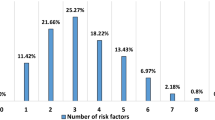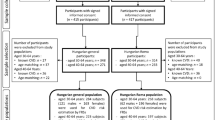Abstract
Objective
The Mashhad stroke and heart atherosclerotic disorder (MASHAD) study is a 10-year cohort study that aims to evaluate the impact of various genetic, environmental, nutritional and psychosocial risk factors on the incidence of cardiovascular events among an urban population in eastern Iran.
Methods
The MASHAD study comprises a cohort of 9704 individuals aged 35–65 years using a stratified cluster random sampling design. This cohort will be followed up until 2020, with follow-up examinations being undertaken every 3 years. Ten-year cardiovascular disease (CVD) risk estimation was determined using NCEP ATP III criteria.
Results
Overall, 88.4 % of women and 79.2 % of men (P < 0.001) had at least one lipid abnormality. The 10-year risk for CVD of <10, 10–20 and >20 % were observed to be 86.6, 11 and 2.5 %, respectively. Predicted risk of CVD > 10 % using the Framingham algorithm was considerably higher in men compared to women. Overall, 9.5 % [95 % confidence interval (CI) 8.9–10.1 %] of our subjects had prevalent CAD.
Conclusion
The prevalence of CVD risk factors within our population is high compared to Western countries, indicating the necessity for interventional risk modifications.

Similar content being viewed by others
References
Azarpazhooh MR, Etemadi MM, Donnan GA, Mokhber N, Majdi MR, Ghayour-Mobarhan M, Ghandehary K, Farzadfard MT, Kiani R, Panahandeh M, Thrift AG (2010) Excessive incidence of stroke in Iran: evidence from the Mashhad Stroke Incidence Study (MSIS), a population-based study of stroke in the Middle East. Stroke 41:e3–e10
Azizi F, Rahmani M, Emami H, Mirmiran P, Hajipour R, Madjid M, Ghanbili J, Ghanbarian A, Mehrabi Y, Saadat N, Salehi P, Mortazavi N, Heydarian P, Sarbazi N, Allahverdian S, Saadati N, Ainy E, Moeini S (2002) Cardiovascular risk factors in an Iranian urban population: Tehran lipid and glucose study (phase 1). Soz Praventivmed 47:408–426
Beaglehole R (1993) Cardiovascular disease in developing countries. BMJ 306:395
Beaglehole R, Stewart AW, Jackson R, Dobson AJ, McElduff P, D’Este K, Heller RF, Jamrozik KD, Hobbs MS, Parsons R, Broadhurst R (1997) Declining rates of coronary heart disease in New Zealand and Australia, 1983–1993. Am J Epidemiol 145:707–713
Castelli WP, Garrison RJ, Wilson PW, Abbott RD, Kalousdian S, Kannel WB (1986) Incidence of coronary heart disease and lipoprotein cholesterol levels. The Framingham study. JAMA 256:2835–2838
Dawber TR, Moore FE, Mann GV (1957) Coronary heart disease in the Framingham study. Am J Public Health Nations Health 47:4–24
Delavari A, Forouzanfar MH, Alikhani S, Sharifian A, Kelishadi R (2009) First nationwide study of the prevalence of the metabolic syndrome and optimal cutoff points of waist circumference in the Middle East: the national survey of risk factors for noncommunicable diseases of Iran. Diabetes Care 32:1092–1097
Ergör G, Soysal A, Sözmen K, Ünal B, Uçku R, Kılıç B, Günay T, Ergör A, Demiral Y, Saatlı G, Meseri R, Baydur H, Simşek H, Budak R, Arık H, Karakuş N (2012) Balcova heart study: rationale and methodology of the Turkish cohort. Int J Public Health 57:535–542
Esteghamati A, Abbasi M, Alikhani S, Gouya MM, Delavari A, Shishehbor MH, Forouzanfar M, Hodjatzadeh A, Ramezani RD (2008) Prevalence, awareness, treatment, and risk factors associated with hypertension in the Iranian population: the national survey of risk factors for noncommunicable diseases of Iran. Am J Hypertens 21:620–626
Geiss LS, Pan L, Cadwell B, Gregg EW, Benjamin SM, Engelgau MM (2006) Changes in incidence of diabetes in US adults, 1997–2003. Am J Prev Med 30:371–377
Hadaegh F, Hatami M, Tohidi M, Sarbakhsh P, Saadat N, Azizi F (2010) Lipid ratios and appropriate cut off values for prediction of diabetes: a cohort of Iranian men and women. Lipids Health Dis 9:85
Hajian-Tilaki KO, Heidari B (2007) Prevalence of obesity, central obesity and the associated factors in urban population aged 20–70 years, in the north of Iran: a population-based study and regression approach. Obes Rev 8:3–10
Harati H, Hadaegh F, Saadat N, Azizi F (2009) Population-based incidence of Type 2 diabetes and its associated risk factors: results from a 6-year cohort study in Iran. BMC Public Health 9:186
Hatano S (1976) Experience from a multicentre stroke register: a preliminary report. Bull World Health Organ 54:541–553
Hippisley-Cox J, Coupland C, Vinogradova Y, Robson J, May M, Brindle P (2007) Derivation and validation of QRISK, a new cardiovascular disease risk score for the United Kingdom: prospective open cohort study. BMJ 335:136
Husten L (1998) Global epidemic of cardiovascular disease predicted. Lancet 352:1530
Kelishadi R, Alikhani S, Delavari A, Alaedini F, Safaie A, Hojatzadeh E (2008) Obesity and associated lifestyle behaviours in Iran: findings from the First National Non-communicable Disease Risk Factor Surveillance Survey. Public Health Nutr 11:246–251
Kuulasmaa K, Tunstall-Pedoe H, Dobson A, Fortmann S, Sans S, Tolonen H, Evans A, Ferrario M, Tuomilehto J (2000) Estimation of contribution of changes in classic risk factors to trends in coronary-event rates across the WHO MONICA Project populations. Lancet 355:675–687
Lloyd BL (1994) Declining cardiovascular disease incidence and environmental components. Aust N Z J Med 24:124–132
Luepker RV, Murray DM, Jacobs DR Jr, Mittelmark MB, Bracht N, Carlaw R, Crow R, Elmer P, Finnegan J, Folsom AR (1994) Community education for cardiovascular disease prevention: risk factor changes in the Minnesota Heart Health Program. Am J Public Health 84:1383–1393
Masoudkabir F, Toghianifar N, Talaie M, Sadeghi M, Sarrafzadegan N, Mohammadifard N, Marshall T, Thomas GN (2012) Socioeconomic status and incident cardiovascular disease in a developing country: findings from the Isfahan cohort study (ICS). Int J Public Health 57:561–568
Monge R, Beita O (2000) Prevalence of coronary heart disease risk factors in Costa Rican adolescents. J Adolesc Health 27:210–217
Najeeb MA (1993) Cardiovascular disease in developing countries. BMJ 306:927
Ornish D, Scherwitz LW, Billings JH, Brown SE, Gould KL, Merritt TA, Sparler S, Armstrong WT, Ports TA, Kirkeeide RL, Hogeboom C, Brand RJ (1998) Intensive lifestyle changes for reversal of coronary heart disease. JAMA 280:2001–2007
Sarrafzadegan N, Talaei M, Sadeghi M, Kelishadi R, Oveisgharan S, Mohammadifard N, Sajjadieh AR, Kabiri P, Marshall T, Thomas GN, Tavasoli A (2010) The Isfahan cohort study: rationale, methods and main findings. J Hum Hypertens 25:545–553
Sarraf-Zadegan N, Boshtam M, Malekafzali H, Bashardoost N, Sayed-Tabatabaei FA, Rafiei M, Khalili A, Mostafavi S, Khami M, Hassanvand R (1999) Secular trends in cardiovascular mortality in Iran, with special reference to Isfahan. Acta Cardiol 54:327–333
Schweigman K, Eichner J, Welty TK, Zhang Y (2006) Cardiovascular disease risk factor awareness in American Indian communities: the strong heart study. Ethn Dis 16:647–652
Slavenka J, Dragana S, Janko J, Miloš E, Jelena M (2014) Status of cardiovascular health in a transition European country: findings from a population-based cross-sectional study. Int J Public Health. 59:769–778
Smith EN, Chen W, Kahonen M, Kettunen J, Lehtimaki T, Peltonen L, Raitakari OT, Salem RM, Schork NJ, Shaw M, Srinivasan SR, Topol EJ, Viikari JS, Berenson GS, Murray SS (2010) Longitudinal genome-wide association of cardiovascular disease risk factors in the Bogalusa heart study. PLoS Genet 6:e1001094
Sytkowski PA, D’Agostino RB, Belanger A, Kannel WB (1996) Sex and time trends in cardiovascular disease incidence and mortality: the Framingham Heart Study, 1950–1989. Am J Epidemiol 143:338–350
Uthoff H, Staub D, Socrates T, Meyerhans A, Bundi B, Schmid HP, Frauchiger B (2010) PROCAM-, FRAMINGHAM-, SCORE- and SMART-risk score for predicting cardiovascular morbidity and mortality in patients with overt atherosclerosis. Vasa 39:325–333
Wilson PW, Garrison RJ, Castelli WP, Feinleib M, McNamara PM, Kannel WB (1980) Prevalence of coronary heart disease in the Framingham Offspring Study: role of lipoprotein cholesterols. Am J Cardiol 46:649–654
Conflict of interest
Authors have no conflict of interest to disclose.
Author information
Authors and Affiliations
Corresponding author
Electronic supplementary material
Below is the link to the electronic supplementary material.
Rights and permissions
About this article
Cite this article
Ghayour-Mobarhan, M., Moohebati, M., Esmaily, H. et al. Mashhad stroke and heart atherosclerotic disorder (MASHAD) study: design, baseline characteristics and 10-year cardiovascular risk estimation. Int J Public Health 60, 561–572 (2015). https://doi.org/10.1007/s00038-015-0679-6
Received:
Revised:
Accepted:
Published:
Issue Date:
DOI: https://doi.org/10.1007/s00038-015-0679-6




